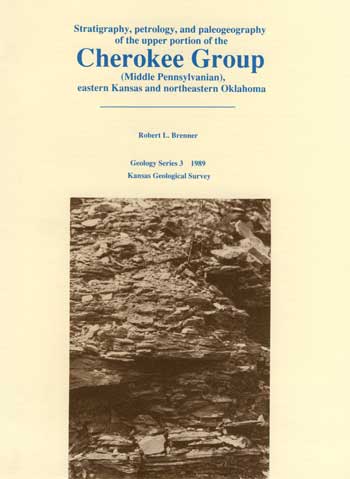Stratigraphy, petrology, and paleogeography of the upper portion of the Cherokee Group (Middle Pennsylvanian), eastern Kansas and northeastern Oklahoma
DOI:
https://doi.org/10.17161/kgsbulletin.no..23537Abstract
The Desmoinesian Cherokee Group of eastern Kansas and adjacent states consists of cyclic sequences of mudrock, thin carbonates, and lenticular sandstones. This study focuses upon the upper portion of the Cherokee Group between two widespread black shale markers: 1) the Oakley shale which underlies the Ardmore limestone and 2) the Excello shale which overlies the Cherokee and forms the base of the Marmaton Group. The study area extends from the Nebraska-Kansas border south through the northern tier of counties in Oklahoma, and from the Kansas-Missouri border west to the Nemaha uplift.
Stratigraphic and sedimentologic interpretations were based on outcrops, well cores, and a grid of geophysical logs from over 1,200 wells. Petrologic interpretations were made primarily from thin sections of well-core specimens, augmented by outcrop specimens. This integrated approach allowed lithologic facies to be identified and mapped. It also helped to demonstrate that the stratigraphic-nomenclature schemes currently in use in eastern Kansas and northeastern Oklahoma are inadequate to describe the three-dimensional stratigraphy of the region. An informal stratigraphic scheme is used to avoid confusion.
Sedimentologic analysis using all available data shows that sandstones are concentrated as shoestring-shaped and thin sheetlike bodies within lobate sediment thicks. These thicks were deposited as deltaic complexes which included fluvial and distributary channel sands, interdistributary muds and marshes, crevasse-splay sands and muds, flood-basin muds and swamps, delta-front sands, and prodeltaic muds. These facies were deposited as delta lobes prograded across the margins of the Pennsylvanian epeiric sea during times of eustatic regression. When lobes were abandoned as distributary channels over-extended themselves, waves and currents reworked their upper portions, winnowing out muds and leaving thin sheetlike lenses of sand. These local transgressive units, lying above the regressive sequences formed by prograding delta lobes, form autocycles within eustatic regressive hemicycles.
During eustatic transgressions, shorelines were shifted northward and eastward very rapidly, moving siliciclastic point sources away from the study area. As a result, transgressing hemicycles are represented by diim reworked sandstone lenses, laterally extensive thin mudrock units, marine limestones, or black phosphatic shales.
Diagenetic alterations profoundly affected petroleum reservoir characteristics of Banzet sandstones. Thin marine sandstone units that were sampled are pervasively cemented, caused by an early stage of carbonate cementation. Some distributary-channel sandstone units have partial chlorite grain coatings, while other units that lack these coatings have well-developed quartz overgrowths that severely reduce both porosity and permeability. Fluvial and distributary-channel sandstones in northeastern Kansas seem to have undergone stages of late-carbonate cementation and concomitant silicate dissolution, followed by dissolution of carbonates. This sequence of events caused the development of significant volumes of secondary porosity, thus enhancing the reservoir characteristics of these sandstone units.
Downloads

Downloads
Published
Issue
Section
License
Copyright (c) 2025 Robert L. Brenner

This work is licensed under a Creative Commons Attribution-NonCommercial 4.0 International License.
